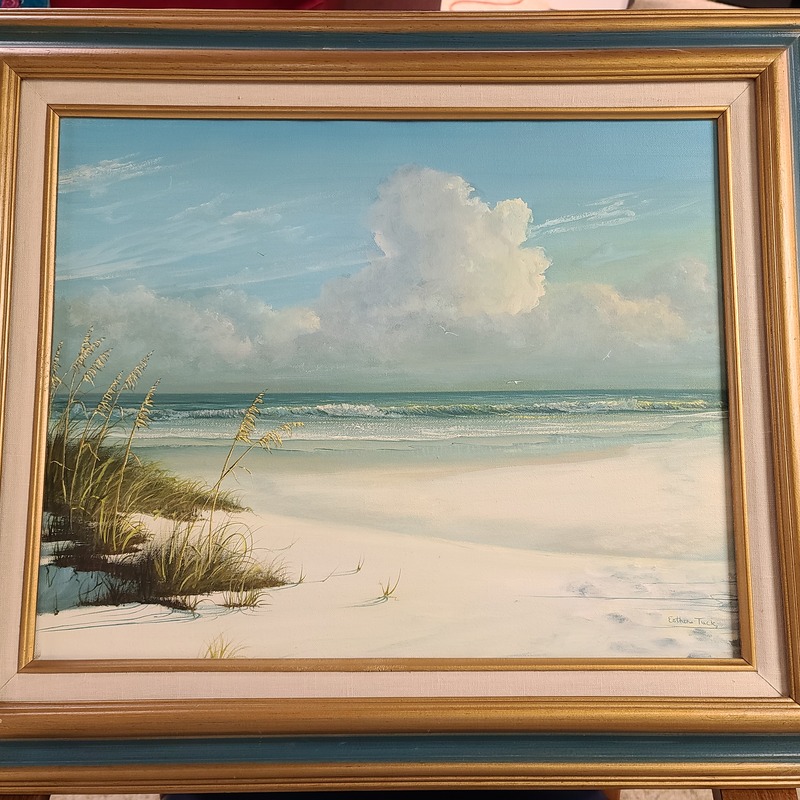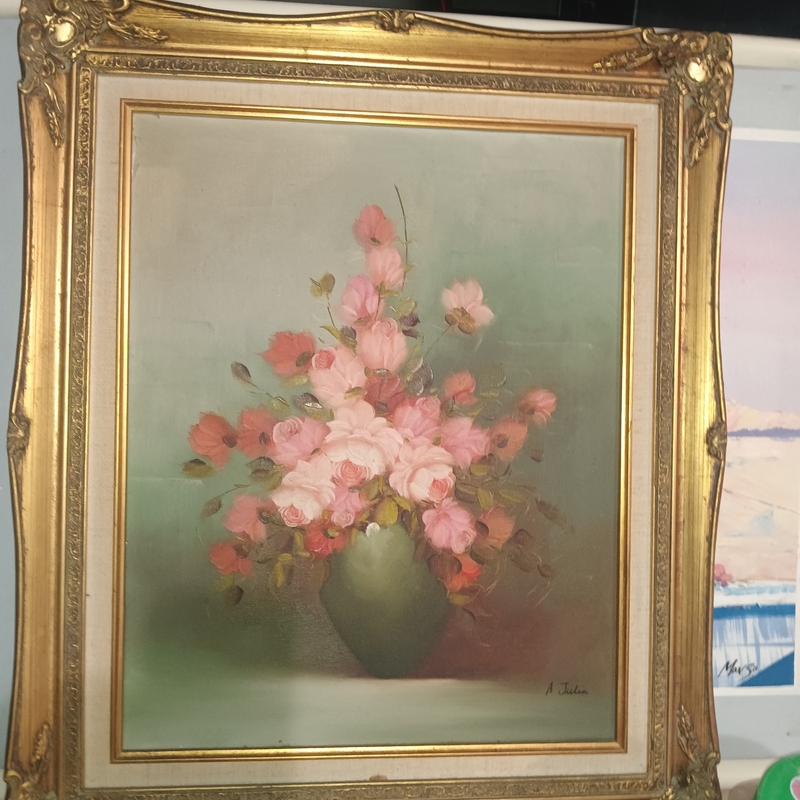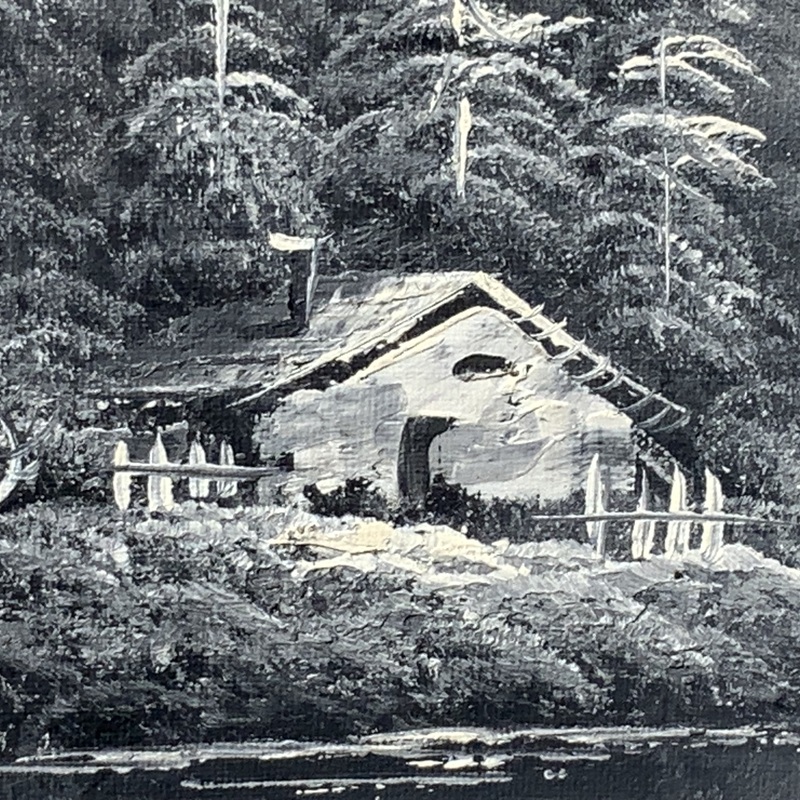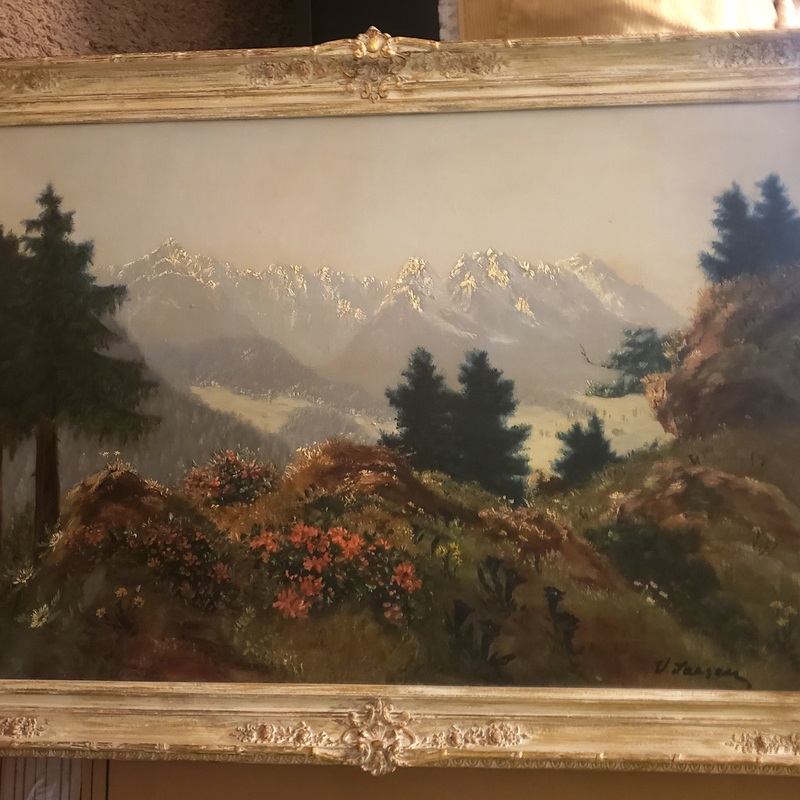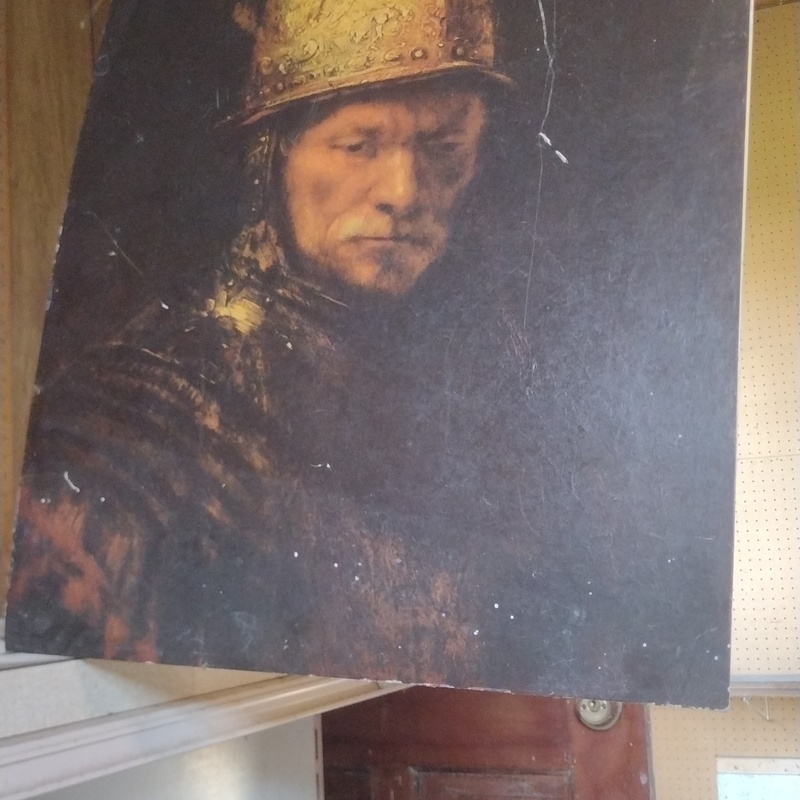
Balinese Maidens Spinning in the Garden, by Adrien Jean Le Mayeur (1880 – 1958)
Note: I can not upload the Certificate of Authenticity, provenance and photos documents since this website does not support PDF file =========== Artist : Adrien Jean Le Mayeur (1880 – 1958) ========== Medium : Oil on canvas with handcrafted frame ========== Signature : “J. Le Mayeur” at the lower right ========== Height : +/- 127 cm ========== Width : +/- 128 cm ========== Period/Date : 1949, acquired in 1949 ========== Country : Bali - Indonesia ========== Condition : Good ========== Re-Examined Date : 26th September 2017 ========== Authentication # : P-1205/25/12/2001 =========== Adrien- Jean Le Mayeur de Merprẻs (1880-1958) was recognized as a member of the Belgian royal family, who was born in Brussels – Belgia. After searching the quiet and peaceful place around the world for several years, he sailed to Bali found Kelandis village in 1932 as the paradise island to enjoy his life and painting. When he arrived at tropical paradise, Sanur, he resided in Kelandis village and made it a spending lure for him as his dwelling to produce his tremendous artworks. Sanur became a hieratic sigh residence narrating how Le Mayeur expressed his esoteric love to a graceful Balinese Legong dancer, Ni Wayan Pollok Tjoeglik (1917 – 1985), a virgin from Kelandis village. Since then, Le Mayeur together with Ni Wayan Pollok concurrently made an ultimate synergy to produce tremendous artworks. Le Mayeur was known as an illustrious impressionist painter who was recognized as the French painter Gauguin of Indonesia. He portrayed the Balinese women portrayal posing in beautiful panoramic sceneries in the garden near the beach. =============== Entitled ‘Balinese Maidens Spinning in the Garden’ that is signed ‘J. Le Mayeur’ at the lower right with an original hand carved Balinese frame, the present work is appreciated for employing a daring vision showing the graceful Balinese maidens at their day-to-day basis routine. Le Mayeur astutely depicted scene of three bare-breasted Balinese women sitting in different pose at spinning. This focal point is placed around the natural landscape of lush garden surrounded by four standing women in different pose with statues of Hindu gods and goddesses. Meanwhile, another four women are portrayed at playing and having fun at the beach and sailboats that all are set as the background. The subject is painted in free-flowing and bold, strong and short brushstroke throughout the painting in predominantly vibrant style and earthly palette of red, green, yellow, blue, orange and beige upon thick canvas. The present work consists of complex brush strokes that vary in the amount of paint used. The artist used colors in order to push emotion onto the audience through contrasting colors and it reflects the artist own mood and surroundings at that time. =============== The subject is exquisitely painted and layered in dense and strong brushstrokes in predominantly vibrant dense red. orange, green pigments capturing two-dimensional effects. Exhibiting the extravagant red and green foliage and delicately red dotted flowers, the painter attested the lush garden in his villa. The orange and yellowish hue colors on the present subject were created in casting a warm glow upon the figures’ naked skins to allow that the subject comes alive what the artist wished to attain. With the mottled sunlight shining through gaps in the figures and ground on the present painting, we can see that the current painting renders the illusion of depth. Its supremely setting of the present work disposes for an impressionist palette by using colors, textures and strokes in playing light and shadow. Therefore, as an impressionist, Le Mayeur characterized this work by the rendition of its light and colors, leading to the epithet of luminist to describe this painting’s style. =============== Inspired by Gauguin’s works in composition, this work was expected to be a mirror that heightens the value of Balinese candidness. The present work delivers a plausibly visual imagery of Balinese women that is strongly and perfectly composed. The artist went beyond visual imagery to deliver the peak of Balinese women beauty to his devotees on the current gorgeous work. He executed how the brushstrokes were placed without doubts, and spontaneously dense brushstrokes were displayed in lively dynamic characters to a two-dimensional medium. As his daring vision, so are his colors. The vibrant and dense colors are applied from center to edges as if colors are the guidelines for the lines of sketch, not the other way around. The usage of colors truly complemented the lush floral beauty, and the femininity of muscular womanhood on the subject. =============== This artwork is a great example in representing other similarly dashing artworks that was created by the artist in the post-World War II era, in 1949. Compared to his earlier works painted in a highly impressionist style with unrestrained interpretation of anatomy exhibiting large hands, elongated arms and bent bodies, the present work shows more detailed execution and complexity in moderate impressionism style. We can appreciate the more details execution on this Le Mayeur’s work, where the subject is painted in multiple layers and dense brushwork with great attention to details from their sharp jaws, sweet visage, strong muscular postures, and healthy figures gaining in complexity with superlative elegance and grace. =============== By depicting the strapping and muscular maidens on this artwork, the artist has successfully conveyed the message describing the hardworking, resilient, strong, and tenacious Balinese women without putting aside their femininity. This phenomenon was commonly found as part of Balinese culture that Balinese women were responsible on supporting their families on their living. The figural portrayal depicted with maiden in weaving around his house's garden on the present painting is one of Le Mayeur’s favorites. Le Mayeur's works are highly sought after in the market and they have been exhibited in major auction houses and the world-renowned museums. Compare with the smaller size (55 x 65 cm) of the artist’s work in similar subject and colors hue entitled to “Three Balinese in the Garden” (55 x 65 cm.) painted in less vibrant tone than that of the present piece, sold at Christie’s Hong Kong, 25th November 2007, lot. 89, for HK$2,287,500; or equivalent to US$294,172, initially estimated between HK$650,000 to HK$800,000 (see fig. 1). Also, compare with his work in “Women in the Garden Preparing Offerings” (75.5 x 90.5 cm), sold at Sotheby’s Hong Kong, 6th April 2013, lot. 339, for HK$ 5,440,000, or equivalent to US$ 700,672, initially estimated between HK$ 3,200,000 – HK$ 4,500,000 (see fig. 2). =============== After reaching his idyllic life in Bali throughout his whole career of the world-wide artwork, Le Mayeur was diagnosed with serious ear cancer in 1958. Accompanied by his wife, the artist then returned to his homebirth, Belgium, to be provided with the necessary care. After a two-month struggle for his life, the maestro passed away on 31st May, 1958. The funeral took place at Ixelles, Brussels, and then his wife Ni Pollok returned to her hometown, Sanur village in Bali-Indonesia, to foster the museum inherited by its maestro until she passed away on the 27th of July, 1985 when she was 68 years old. ===============
Height : +/- 127 cm ===== Width : +/- 128 cm
PROVENANCE OF ARTWORK: Lo Wing Tjong (1851 – 1934) to Liem Guan Kwee (22th September 1901 – 25th March 1985) to Liem Syuhada (12th June 1927 – 22nd April 2000) to Current Owners (Descendants) ============ The present painting was acquired directly from the artist in 25th March 1949 in Bali Island by Liem Guan Kwee (22th September 1901 – 25th March 1987), a son of Lo Wing Tjong (1851 – 1934), a Diplomat and Chinese community leader in Batavia under Guangxu reign (1875 – 1908) of China. He acquired the present artwork when he and his family fled to Bali Island on December 1948 because of a Dutch Military Aggression II against the Republic of Indonesia. When living in Bali in early 1949, Liem Guan Kwee visited the artist’s studio to commission and acquire the present artwork. Therefore, the acquisition of the present piece was one year after a Dutch Military Aggression II against the Republic of Indonesia that was tempestuous in 19th December 1948 – January 1949 in Indonesia after negotiations between Indonesian and Dutch military failed. =============== During the aggression and attack, the Dutch managed to capture the Indonesian Republic's temporary capital, Yogyakarta, and seized Indonesian leaders such as Republican President Sukarno. Referred to by the Dutch as the second of two "Politionele acties" ("Police Actions"), it is known in Indonesia as Agresi Militer Belanda II ("Dutch military aggression II"). The second Politionele Actie was aimed at forcing the Republic to cooperate with the Dutch government in the implementation of the federalist policy as stipulated in the Linggadjati Agreement. Liem and his family fled to save their life in Bali Island in 1948 - 1950. In Bali, he visited Le Mayeur’s studio and met the artist to acquire the present artwork on March 1949. On March 1949, the present artwork was brought home by ship from Bali to Batavia (Jakarta). =============== In 2001, the present artwork was researched and authenticated by team of National Archaeology, Art and Culture Foundation in person deriving from Southeast Asia artworks, paintings and Chinese ceramics experts. The foundation itself was led by Professor Abu Ridho, an Asian art scholar and consultant, former curator of National Museum of Jakarta – Indonesia, and author of Chinese art books. The physical examination of this artwork and its authenticity is certified on an official letter of statement and agreement that was signed by professor and legalized by public notary ‘Royani, SH’, dated 8th April 2002. In 2004, the government of Republic of Indonesia recorded this legacy especially regarding with its authenticity, historical artwork and the ownership of property or legal rights. This artwork was appreciated and archived officially as a national cultural heritage object by Culture and Museum Agency of Government of Indonesia, Jakarta, number 863/-1-853.3, dated 14th April 2004. =============== In 2018, this artwork was re-researched by team of National Archaeology, Art and Culture Foundation. The team of experts in the respective field re-researched and re-analyzed this artwork by more elaborate manner. The re-research and re-analyzing include its technical or stylistic analysis, documentary research and comparison with similar artist or periods. All of them are relied on archives, art libraries and reputable art and antique commercial institutions or auction houses enabling to strongly establish its eligible quality and authenticity. All documents and photos of its provenance and certificate of authenticity are included in separated page. ===============
Inherited
Yes


Dear Faisal,
Thank you for contacting Mearto with your appraisal inquiry again and we hope you are well.
The presented object appears to be a painting oil on canvas with the measurements of 127 x 128 cm. This painting depicts several Balinese women spinning and weaving under trees. This painting has the title: Balinese Maidens Spinning in the Garden. It appears to be made, signed by Adrien Jean LE MAYEUR DE MERPRES (1880-1958). It comes from a private collection.
Comparable objects were recently offered and sold on the international auction market.
This piece is in good condition and there is no severe damage visible in the images provided.
A fair market estimation for an authentified artwork by Adrien Jean LE MAYEUR DE MERPRES (1880-1958) with this motif and in this size would be between 500.000 to 800.000 USD.
This estimate is based on actual recent past recorded auction sales of comparable items. Retail "asking prices" can be higher and may vary.
An artwork of such high potential value requires further authentication research. This estimate is provided on the condition of authenticity.
With kind regards,
George



